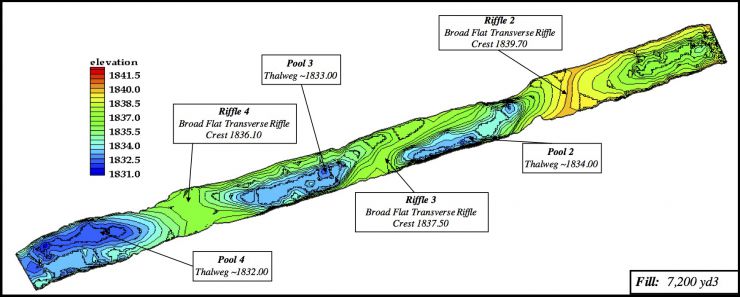TR Design 1
Concept
The concept for Design 1 was to build up three existing riffles and increase overall bed slope through slope creation (Elkins et al., 2007), yielding a high riffle-pool relief of 1.54 m. Accentuating the riffle topography yielded a riffle-pool asymmetry of 2.18. Apart from the height change, this design conceptually “goes with the flow,” because the new landforms follow existing contours and accentuate the existing pools and riffles to retain and focus the existing thalweg. Topographically high areas were built up with gravel/cobble and corresponding low areas were left alone. The thalweg was not manipulated. The three large riffles were conceived to provide for salmon spawning, the pools for adult holding, and the low-velocity bank fringe for fry habitat. It was hypothesized that increasing the slope between riffles 2 and 3 would provide more potential energy to be distributed downstream to enhance channel hydraulic processes (e.g., hyporheic exchange, eddy formation and fine particle flushing, and increased probability of D90 entrainment at high discharges). Through the creation of slope, which can serve as a driver of many ecohydraulic processes, it was envisioned that greater fluvial complexity would be enabled in many of the designs. Design One required an estimated 5,505 m3 of gravel and cobble to construct it.
Design Map

Design Hypotheses
| Attributes | Riffle 2 | Pool 2 | Riffle 3 | Pool 3 | Riffle 4 |
| Hydraulic |
Transverse riffle placed upstream of existing artificial riffle-weir to avoid high velocities on backside of weir. At riffle exit, constriction promotes flow convergence over subsequent pool. | Constrictions at pool entrance and pool exit will induce flow convergence, flow acceleration, and eddy formation adjacent to banks. | Oblique transverse riffle will cause flow divergence over riffle and then convergence on right after riffle. Depending on riffle height, an eddy may form downstream of the riffle on left. | Proto-pool behind riffle crest on right receives focused flow and promotes habitat diversity. Pool depth accentuated. | Broad flat riffle with shallow, moderate flow optimized for spawning. |
| Geomorphic | Scour at riffle exit constriction. Higher likelihood of scour on river left than river right of riffle due to flow constriction. |
Pool uses existing contour regime. Focused thalweg and sediment deposition along periphery in eddies will promote pool self-maintenance |
Transverse riffle tracks existing contours. Crest length extended by oblique orientation. Divergent flow promotes spawning-flow riffle stability. |
Constricted pool tracks existing contours. Constriction promotes self-maintenance |
At spawning Q, velocity is below threshold for scour. |
| Fisheries | -Spawning on river left of riffle and on riffle crest. -Increased fry habitat along riffle periphery. |
-Adult holding habitat in pool. -Fry habitat created over channel constriction features. -Spawning on peripheral pool benches. |
-Spawning habitat on riffle. -Pool-exit rim shape promotes gravel oxygenation and provides good habitat. -Increased fry habitat along riffle periphery. |
-Adult holding habitat in pool. -Fry habitat created over channel .constriction features -Spawning on peripheral pool benches. |
-Spawning on entire riffle. -Pool-exit rim shape promotes gravel oxygenation and provides good habitat. -Increased fry habitat along riffle periphery. |
Design Testing with FESWMS 2D Model
System response was evaluated in terms of flow pattern, fish habitat quality, and sediment transport regime at three discharges within the regulated range permitted by operational rules at the time. At the links below, the results are shown for two of those discharges: (1) a typical baseflow (300 cfs) present during most of the year when fish are spawning and embryos are incubating and (2) the peak regulated flood discharge released by the dam at that time (6000 cfs).
Click links below to see model results:


